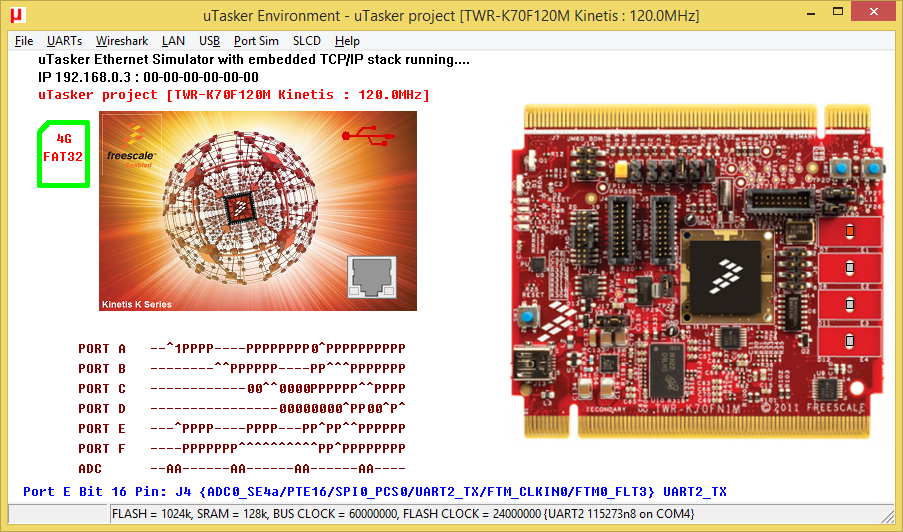TWR-K70F120M

This Freescale tower board is based on the K70FN1M0VMJ12 which is a 120MHz device from the performance and integration K70 family with Cortex-M4 core, FPU, Ethernet and USB. This K70 device has 1M Flash and 128k SRAM and is in an 256 pin MAPGBA, whereby the K70 is also avilable in 196 MAPBGA. A 150MHz version in 256 MAPBGA is also offered. There is a 50MHz oscillator on the board for clocking the part and the board is often used in the tower kit together with the TWR-SER board which supplies the Ethernet interface.
Full details and documentation for this board can be obtained from the Freescale web site: TWR-K70F120M
To configure the µTasker project for this board simply enable the define TWR_K70F120M in the project's config.h file. The compiler needs to be set to build for Cortex M4 (and not Cortex M0+) and the linker script K_1M_128.ld should be selected [K_1M_128_BM.ld for downloadable version] {the linker script extension may vary for different compilers, whereby *.ld is valid for GCC}
TWR-K70F120M Binaries
Here are some binary files that can be loaded to the board. These were built using the µTasker applications (serial loader and V1.4 application)
and can be simply generated using the supported compilers/IDEs [these were built using GCC], built using different configuration options or modified to
suit specific requirements or hardware derived from this board (the TWR-K70F120M should be built into a tower kit with TWR-SER for Ethernet and USB and also supplying a 50MHz clock - for suitable jumper settings see the µTasker Kinetis K60 demo user's guide) :
-
uTaskerSerialBoot_TWR-K70F120M_KBOOT_HID_UART_MSD_SDHC.bin KBOOT compatible USB-HID loader with composite USB-MSD loading, as well as KBOOT UART loading on UART 2 (available on TWR-SER RS232 interface or OSJTAG virtual COM) at 57'600 Baud, or from an inserted SD card [24.2k]
allowing applications to be loaded at link address 0x8080 (using Freescale's KBOOT USB connection, or KBOOT UART at 57'600 Baud or USB-MSD when the board appears as upload hard disk or as a file on the SD card).
When operating, the red LED blinks at 5Hz. To force the loader, reset the board with push button SW2 held down.
To disable the watchdog, reset the board with push button SW1 held down.
This can be loaded using CodeWarrior's Flash utility via the TWR-K70F120M's OSJTAG debug interface. Note that the loader limits application sizes to 130k - it can be built without limits using the µTasker project. When forcing the boot loader, hold the switch for about 5s; this ensures that the application is not started once the SD card check has completed. -
uTaskerV1.4.8_BM_TWR-K70F120M_8080.bin TWR-K70F120M application with command-line menu on the UART 2 (TWR-SER RS232 interface at 115'200 Baud or OSJTAG virtual COM) with various menu items.
Output from the on-board accelerometer can be viewed in the I2C menu. The USB device is USB-MSD and so the board appears as a hard drive to the PC when the SD card is inserted into the socket on the board. Files can then be read and written
to the SD card from the PC and also worked with via the DOS-like command line interface in the disk-interface sub-menu.
The processor runs at 120MHz. [94.5k].
Linked to 0x8080, this binary image can be loaded with drag-and-drop onto the upload disk that appears when the serial loader is operating or using the KBOOT loader's USB or UART connections. When the application is running, the red LED blinks at 2.5Hz.
The application includes Ethernet TCP/IP operation on a default IP address of 192.168.0.3, which can be modified in the command line menu if desired. The command line menu is also available via Telnet and the web server will serve pages found on the SD card in a directory called "web", where the start page should be named "index.htm".
Low power modes are not enabled in this software due to errata e7166 which can effect this chip when operating with USB.
Although the SDRAM on the TWR-K70F120M is not used by the program it is configured and can be written/read using the memory interface in the I/O menu, whereby it is memory mapped from 0x70000000. - software.bin The same TWR-K70F120M application that can be copied to the SD card and will be loaded to the processor when the board starts [95.5k] (the name is required for it to be recognised - see the Serial Loader User's Guide for more details).
- uTaskerV1.4.8_TWR-K70F120M.bin The same TWR-K70F120M application as stand-alone software that can be loaded using CodeWarrior's Flash utility via the TWR-K70F120M's OSJTAG debug interface [95k].
Return to the Kinetis landing page
µTasker Kinetis TWR-K70F120M support. Copyright (c) 2004..2018 M.J.Butcher Consulting